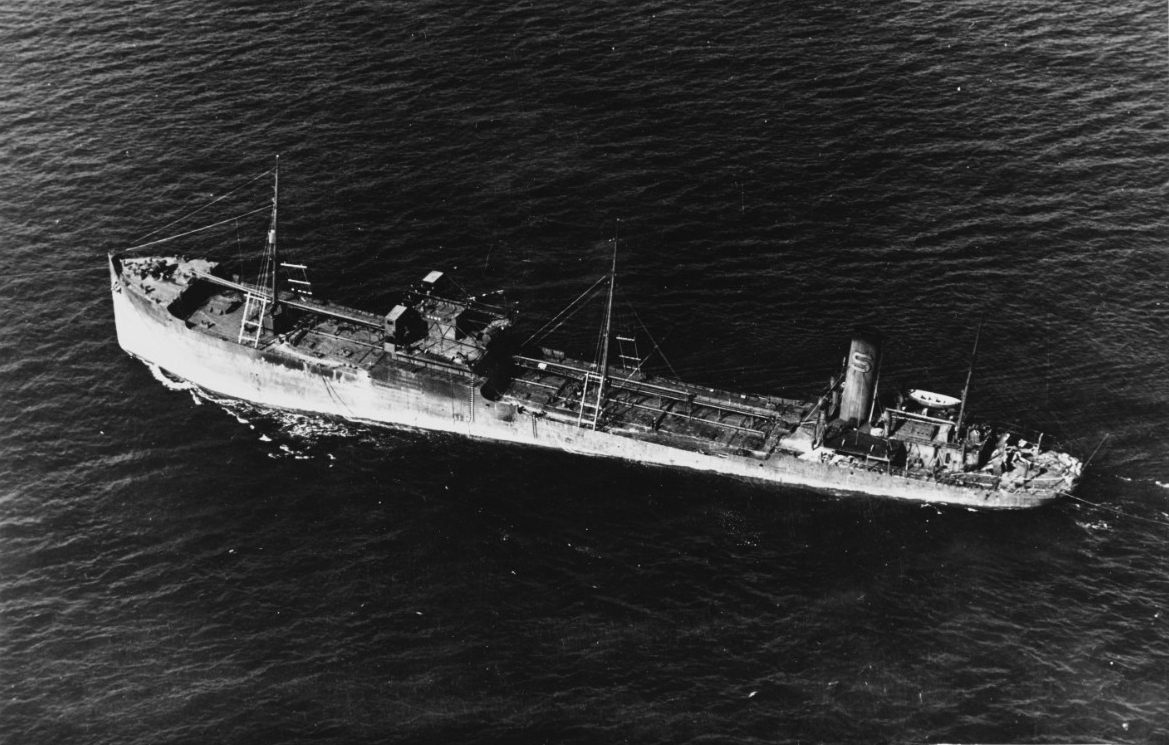Abarenda II (IX-131)
1944–1946
The second Abarenda was named to honor the service of the previous ship of that name.
II
(IX-131: displacement 19,410 (full load); length 435'0"; beam 56'0"; draft 25'6" (full load); speed 10.2 knots; complement 120; armament none)
The single-screw tanker Acme, built for the United States Shipping Board, was completed in 1916 at San Francisco, Calif., by the Union Iron Works. The vessel underwent an inspection in the Twelfth Naval District on 7 December 1917. Assigned the identification number (Id. No.) 2103, Acme was not taken over by the Navy during the Great War (which later came to be known as World War I). As World War II engulfed much of the globe (1939-1941) and drew the U.S. into hostilities, Acme was operating under the house flag of the Socony-Vacuum Oil Co. of New York, N.Y., in the petroleum trade.
Unarmed and in water ballast, Acme, 47-year old Sigismund Schulz, of Pleschen, Germany, master, had sailed from New York on 15 March 1942 for Corpus Christi, Texas, and on the 17th, near the end of the first watch, was steaming singly, blacked-out, about a mile west of the Diamond Shoals Light Buoy off the coast of North Carolina. Although not in convoy, Acme steamed in proximity to Allied shipping, steering an undeviating, non-zig-zag course at 10.5 knots, with at least seven merchantmen and the destroyer Dickerson (DD-157) and the Coast Guard Cutter Dione (WPC-107) in the vicinity.
Also nearby, however, lurked the German Type IXB submarine U-124 (Kapitänleutnant Johann “Jochen” Mohr, 25 years old, commanding). On her third war patrol (begun on 21 February) out of Lorient, occupied France, she had already sunk two ships, one of which, the Honduran-flagged merchantman Ceiba, had been en route to New York with a cargo of bananas. U-124 had sent her to the bottom during the mid watch that same day (0226) with a heavy loss of life (including women and children).
At 2352, a G7E torpedo (Nummer 14319) from U-124 punched into Acme’s hull aft of her stack, following a 600-meter run, destroying the tanker’s engine room and killing the three watchstanders instantly, while the ship’s rudder and propeller, blown free of the ship by the explosion, plunged to the bottom of the Atlantic. Forward of the destruction wreaked by the torpedo, however, the bulkheads held.
As the crew prepared to abandon ship (having lost one officer and ten men all told), a search revealed the injured second engineer and one fireman with two broken legs. Their able-bodied shipmates assisted them into lifeboats, and at 0120 on 18 March 1942, Capt. Schulz and 19 other survivors left the vessel. The cutter Dione rescued them from two lifeboats in a little over 10 minutes’ time and transported them to Norfolk, Virginia, where she put them ashore.
The shipwrights of Union Iron Works had built a sturdy vessel. Acme remained stubbornly afloat, her stern settling until it came to rest on the bottom. Salvage ensued, with U.S. Navy and Coast Guard vessels bringing Acme to Lynnhaven Roads, Va.; ultimately, she was taken to Newport News, Va., where repairs restored her to serviceable condition.
Acme, down by the stern following her being torpedoed by U-124 on 17 March 1942, rides at the end of a tow line, ultimately bound for Newport News. Note the block letter “S” on her funnel, signifying her operators, Socony [Standard Oil Co. of New York]-Vacuum Oil Co. (U.S. Navy Photograph 80-G-177204, National Archives and Records Administration, Still Pictures Division, College Park, Md.)
Kapitänleutnant Mohr, meanwhile, continued to command U-124 with distinction, receiving the Knights Cross (27 March 1942 after returning from the successful third patrol that had seen his boat sink seven ships and damage three) and the Knights Cross with Oak Leaves (13 January 1943). During a return voyage to Lorient, Mohr composed a ditty that dealt with destruction of tankers: “The moon night is as black as ink/Off Hatteras the tankers sink/While sadly Roosevelt counts the score/some fifty thousand tons. Mohr.” He served his entire submarine career in U-124, and died with her when she was sunk with all hands (53 souls all told) on 2 April 1943, less than a week into her sixth patrol. He had been promoted to Korvettenkapitän the previous day.
Acme, meanwhile, was transferred by Socony-Vacuum to the War Shipping Administration (WSA) under a term charter agreement at Newport News at noon on 20 April 1942. On 30 September 1943, the ship was transferred to the custody of Tankers Co. under a general agency agreement at Melville, Rhode Island, at 8:00 a.m. that day.
Acme was renamed Abarenda on 3 November 1943 and simultaneously designated as an unclassified vessel, IX-131, in advance of her purchase by the Navy that occurred at noon on 26 February 1944 at Nouméa, New Caledonia. Under a bareboat charter, Abarenda was commissioned at Nouméa on 18 April 1944, Lt. Cmdr. Benjamin F. Langland, USCGR, in command.
Assigned to Service Squadron 10 as a floating storage tanker, Abarenda served at Manus in the Admiralty Islands until 20 February 1945 when she headed for the Philippines. The tanker arrived at Leyte on 13 March and, for the remainder of hostilities, dispensed fuel to the warships of the Third and Fifth Fleets.
Following the end of World War II, Abarenda fueled the vessels supporting the occupation forces in the Far East and continued that duty until 2:15 p.m. on 28 February 1946 at which time she was decommissioned at Subic Bay, Philippines, returned to the WSA, and berthed with that agency's reserve fleet in Subic Bay. Her name was stricken from the Navy Register on 20 March 1946.
She retained the name Abarenda while in reserve. Sold on 29 January 1948 to the Asia Development Corp., Shanghai, China, along with 15 other vessels, for scrapping, the ship that had survived the attack by one of the Kriegsmarine’s best U-boat commanders was delivered to her purchaser on 3 March 1948.
Updated, Robert J. Cressman
12 July 2022



